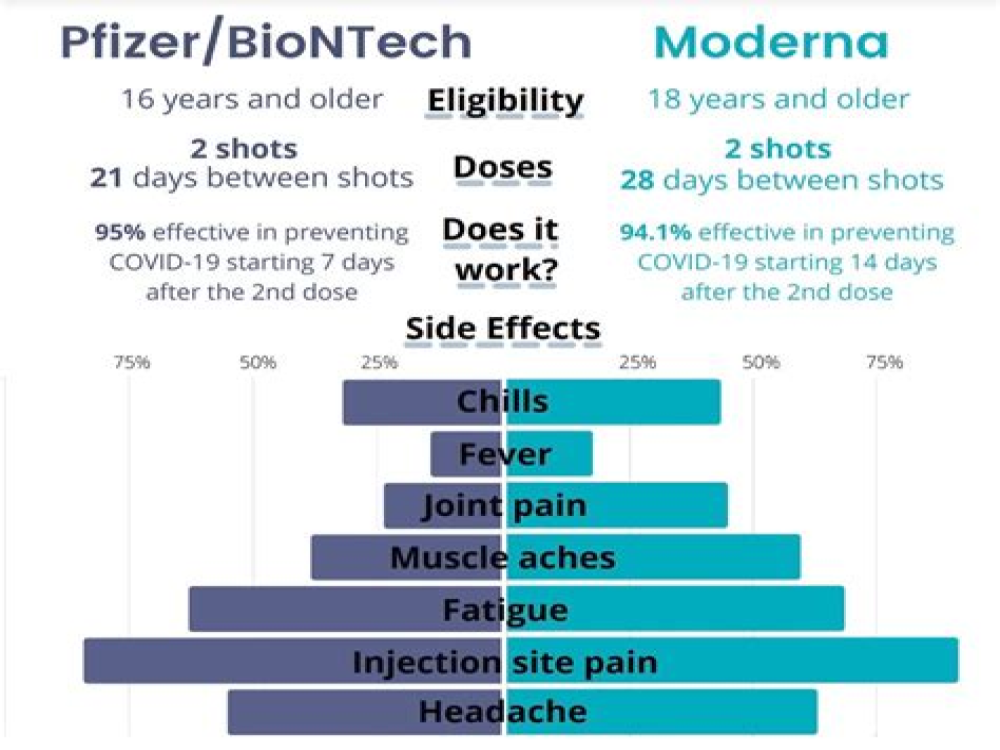Authors: Johanna Chapin-Bardales, PhD, MPH1; Julianne Gee, MPH1; Tanya Myers, PhD, MSc1
In December 2020, 2 mRNA-based COVID-19 vaccines (Pfizer-BioNTech and Moderna) were granted Emergency Use Authorization by the US Food and Drug Administration as 2-dose series and recommended for use by the Advisory Committee on Immunization Practices.1–3 In late February 2021, the US Food and Drug Administration granted Emergency Use Authorization for a third COVID-19 vaccine, a single-dose adenovirus vector-based vaccine from Janssen (Johnson & Johnson).
In clinical trials of the mRNA-based 2-dose vaccines, participants reported local and systemic reactions (reactogenicity).4,5 Frequently reported reactions included injection site pain, fatigue, and headache; greater reactogenicity was reported following the second dose.4,5 Continued monitoring of reactogenicity of COVID-19 vaccines outside of clinical trial settings may provide additional information for health care practitioners and the public about transient local and systemic reactions following COVID-19 vaccination.
V-safe Active Surveillance System
To facilitate rapid assessment of COVID-19 vaccines, in 2020, the Centers for Disease Control and Prevention (CDC) established v-safe, a new active surveillance system for collecting near–real-time data from COVID-19 vaccine recipients in the US. V-safe participants voluntarily self-enroll and receive periodic smartphone text messages to initiate web-based health surveys from the day of vaccination (day 0) through 12 months after the final dose of a COVID-19 vaccine.6 From day 0 through day 7 after each vaccine dose, participants are asked questions about solicited local and systemic reactions (eg, injection site pain, fatigue, headache). These solicited reactions do not include allergic reactions or anaphylaxis; however, v-safe does allow participants to enter free-text information about their postvaccination experience and asks about adverse health events (eg, received medical care). Medically attended events are followed up on through active telephone outreach; future analyses will address these adverse vaccine experiences. This report describes information on solicited local and systemic reactogenicity reported to v-safe on days 0 to 7 after each dose of vaccine from December 14, 2020, through February 28, 2021. Responses were limited to individuals who were vaccinated by February 21, 2021, to allow a 7-day reporting period after the day of vaccination. Preliminary data from v-safe through January 13, 2021, have been previously reported.7 This activity was reviewed by the CDC and was conducted consistent with applicable federal law and CDC policy (see Additional Information).
Self-reported Local and Systemic Reactions Among V-safe Participants
By February 21, 2021, more than 46 million persons received at least 1 dose of an mRNA-based COVID-19 vaccine.8 A total of 3 643 918 persons were enrolled in v-safe and completed at least 1 health survey within 7 days following their first vaccine dose; 1 920 872 v-safe participants reported receiving a second vaccine dose and completed at least 1 daily health survey within 7 days following the second dose. Solicited local and systemic reactions during days 0 to 7 after each dose were assessed.
Most v-safe participants reported an injection site reaction (dose 1: 70.0%; dose 2: 75.2%) or a systemic reaction (dose 1: 50.0%; dose 2: 69.4%) during days 0 to 7 after vaccination (Table). The most frequently reported solicited local and systemic reactions after the first dose of COVID-19 vaccine were injection site pain (67.8%), fatigue (30.9%), headache (25.9%), and myalgia (19.4%). Reactogenicity was substantially greater after the second dose for both vaccines, particularly for systemic reactions, including fatigue (53.9%), headache (46.7%), myalgia (44.0%), chills (31.3%), fever (29.5%), and joint pain (25.6%).Table. Solicited Local and Systemic Reactionsa to mRNA-Based COVID-19 Vaccines Reported 0 to 7 Days After Vaccination—Centers for Disease Control and Prevention V-safe Surveillance System, December 14, 2020, to February 28, 2021 View LargeDownload

A greater percentage of participants who received the Moderna vaccine, compared with the Pfizer-BioNTech vaccine, reported reactogenicity; this pattern was more pronounced after the second dose (Table). When stratified by age (<65 vs ≥65 years), differences in reactogenicity by vaccine remained consistent with overall findings (data not shown). Local and systemic reactions were less commonly reported by v-safe participants 65 years and older compared with those younger than 65 years, but greater reactogenicity after the second dose was observed for both age groups (eFigure in the Supplement). For both doses of both vaccines, the percentage of v-safe participants who reported local and systemic reactions was highest on day 1 after vaccination and declined markedly through day 7.
For More Information: https://jamanetwork.com/journals/jama/fullarticle/2778441
